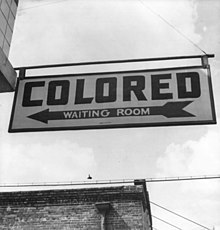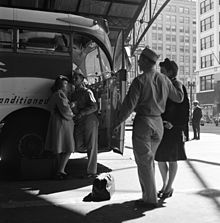Esther Bubley
Esther Bubley (born February 16, 1921 in Phillips , Wisconsin , † March 16, 1998 in New York City ) was an American photographer . Her specializations were expressive photography and the everyday life of ordinary people.
life and career
Esther Bubley was born in Philips on February 16, 1921. She was the fourth child of Russian Jewish immigrants Louis and Ida Bubley. The Central High School in 1936 when Bubley in Superior (Wisconsin) visited, which was Life magazine first published. It was through this, and especially the images of the Great Depression of the Farm Security Administration, that she developed her passion for photojournalism and documentary photography . As editor-in-chief of her college yearbook, she tried to mimic the style of Life magazine. After high school, Bubley spent two years at what is now the University of Wisconsin-Superior before enrolling in the year-long photography program at what is now the Minneapolis College of Art and Design .
In 1941, after completing the collage, Bubley moved to Washington, DC , where she was looking for work as a photographer. Since she couldn't find anything at first, she moved to New York City, where she got a job with Vogue magazine . Not liking the work, she moved back to Washington in 1942, where she was offered a position as a microfilmer at the National Archives and Records Administration .
In the fall of 1942, she hired Roy Striker as a darkroom assistant at the Office of War Information (OWI). With the help of Stryker and other superiors, Bubley got a job as a photographer to document life on the home front during the war. Her most challenging job was a series about the bus system in the Midwest and South.
In late 1943, Bubley left the OWI with Stryker and other photographers and worked with them on projects for Standard Oil . Her series "Bus Story" for the company won the prize for the best picture sequence at the Contest of the Encyclopædia Britannica and the University of Missouri in the category "News Pictures of the Year" in 1948. During this time she married Edwin Locke, Strykers Head of administration, but divorced him shortly afterwards.
From 1947 onwards, Bubley no longer worked only for Stryker and Standard Oil. She began working on the side for the Children's Bureau , a children's charity. In the following years she contributed thousands of pictures to the work of the organization. Her photos have appeared on more than thirty front pages of The Child magazine.
In 1949, Bubley won the Encyclopædia Britannica and University of Missouri School of Journalism's second photo contest with a report on mental illness in the Ladies' Home Journal . She continued to work for the journal and produced several articles for the "How America Lives" series, which was published between 1948 and 1060.
In 1951 she started working as a freelancer for Life magazine. She contributed about forty articles and two cover stories during her collaboration. She was one of the first women who was successfully employed as a freelancer for a large magazine. Bubley also produced a notable series that year on the Children's Hospital of Pittsburgh for Stryker, who was in charge of the Pittsburgh Photo Library at the time. Edward Steichen , at that time director of photography at the Museum of Modern Art in New York City, used thirteen photos from the series about the Children's Hospital in Pittsburgh for the exhibition "Diogenese with a Camera" in 1952. This series of photos also led her to cover medical topics more often in her projects. In 1953 she was commissioned by UNICEF and the French government to travel to Morocco and record a documentary there on trachomas . Bubley submitted one of the photos taken there to "Photography Magazine" in 1954, where she became the first woman to win the competition.
In 1955, Steichen included her work in the exhibition The Family of Man .
A year later, she was hired by Pepsi Cola to represent Latin America for the company's Panorama magazine .
In the mid-1960s, Bubley was twice sent around the world by Pan American World Airways to take pictures for their photo collection.
In the late 1960s, when sales of photo magazines fell, Bubley cut back on her activities and stopped traveling the world as much. Instead, she spent more time at home in New York City, where she pursued projects of personal interest and published two children's books on animals and a book on macro photography of plants. In the mornings she was always out with her dog in Central Park , taking photos and taking notes with which she wanted to write a book about the park. In 1991 she was awarded an honorary doctorate from the Minneapolis College of Art and Design . In 1998, Bubley died of cancer in New York City.
In 2001 an exhibition of Bubley's work was shown at the UBS Art Gallery in New York City. In 2005 the Aperture Foundation published a monograph on Bubley, Esther Bubley. On assignment by Bonnie Yochelson and Tracy A. Schmid, archivist of the Bubley estate. In 2010, the Library of Congress published another monograph on Bubley: Fields of Vision. The Photographs of Esther Bubley .
Awards
- 1943 Distinctive Merit from the Art Directors Club .
- 1948 and 1949 First places from the School of Journalism ( University of Missouri ) and the Encyclopædia Britannica .
- 1951 Third place in the Life Magazine competition for young photographers .
- 1954 First place in Photography Magazine , International Competition,.
- 1958 First place from the Art Directors Club,.
- Honorary Doctorate from Minneapolis College of Art and Design , 1991.
Selected exhibitions
- In and out of focus . Museum of Modern Art , New York, NY, 1948.
- Six Women Photographers . Museum of Modern Art, New York, NY, 1950.
- Diogenes with a Camera . Museum of Modern Art, New York, NY, 1952.
- Family of Man . Museum of Modern Art, New York, NY, 1955.
- Esther Bubley . Limelight Gallery, New York, NY, 1956.
- Out of the forties . Amon Carter Museum , Fort Worth , TX, 1983.
- Documenting America, 1935-1943 . Library of Congress , Washington, DC , 1988.
- On assignment. Documentary Photographs from the 1930s and 1940s by Marion Post Wolcott and Esther Bubley . Art Institute of Chicago , Chicago , IL, 1989.
- Esther Bubley. On Assignment, Photographs Since 1939 . University at Buffalo , Buffalo , NY, 1990.
- Photographs by Esther Bubley . Phillips Collection , Washington, DC, 1995.
- The American Century. Art & Culture 1900–1950 . Whitney Museum of American Art , New York, NY, 1999.
- Esther Bubley. American photojournalist . UBS Art Gallery, New York, NY, 2001.
- Breaking the frame. Pioneering Women in Photojournalism . Museum of Photographic Arts , San Diego , CA, 2006.
- Children's Hospital 1951. Photographs by Esther Bubley . Frick Art & Historical Center , Pittsburgh , PA, 2009.
literature
- Zoo pals: Big cats, great apes — a look at zoo life , January 1, 1960
- How Puppies Grow , 1971, Millicent E. Selsam (Author), Esther Bubley (Illustrator), ISBN 978-0-590-40974-2
- How Kittens Grow , 1973, Millicent E. Selsam, ISBN 978-0-590-07409-4
- A Mysterious Presence: Macrophotography of Plants , text by Percy Knauth, July 1979, ISBN 978-0-911104-99-8
- Esther Bubley's World of Children in Photographs , June 1982, ISBN 978-0-8446-5880-3
- Charlie Parker , November 1995, Hank O'Neal (text), Esther Bubley (photographer), ISBN 978-2-85018-223-5
- Esther Bubley: On Assignment , April 2005, Bonnie Yochelson, ISBN 978-1-931788-57-1
- Fields of Vision: The Photographs of Esther Bubley , March 2010, Amy Pastan (series editor), ISBN 978-1-904832-48-5
Movie
- Esther Bubley: A Life in Photography on YouTube a short documentation video , 9 min
- That's Pediatrics documentary video about Bubley's pictures of the Children's Hospital of Pittsburgh, 22 min
Web links
- Esther Bubley, official website
- Women Photojournalists: Esther Bubley
- Women Come to the Front (Library of Congress Exhibition). Billey's career in World War II
- Photography Review, The New York Times , August 17, 2001
- "Private Eye" , Smithsonian Magazine , March 2004
| personal data | |
|---|---|
| SURNAME | Bubley, Esther |
| BRIEF DESCRIPTION | American photographer |
| DATE OF BIRTH | February 16, 1921 |
| PLACE OF BIRTH | Phillips, Wisconsin |
| DATE OF DEATH | March 16, 1998 |
| Place of death | New York City |






